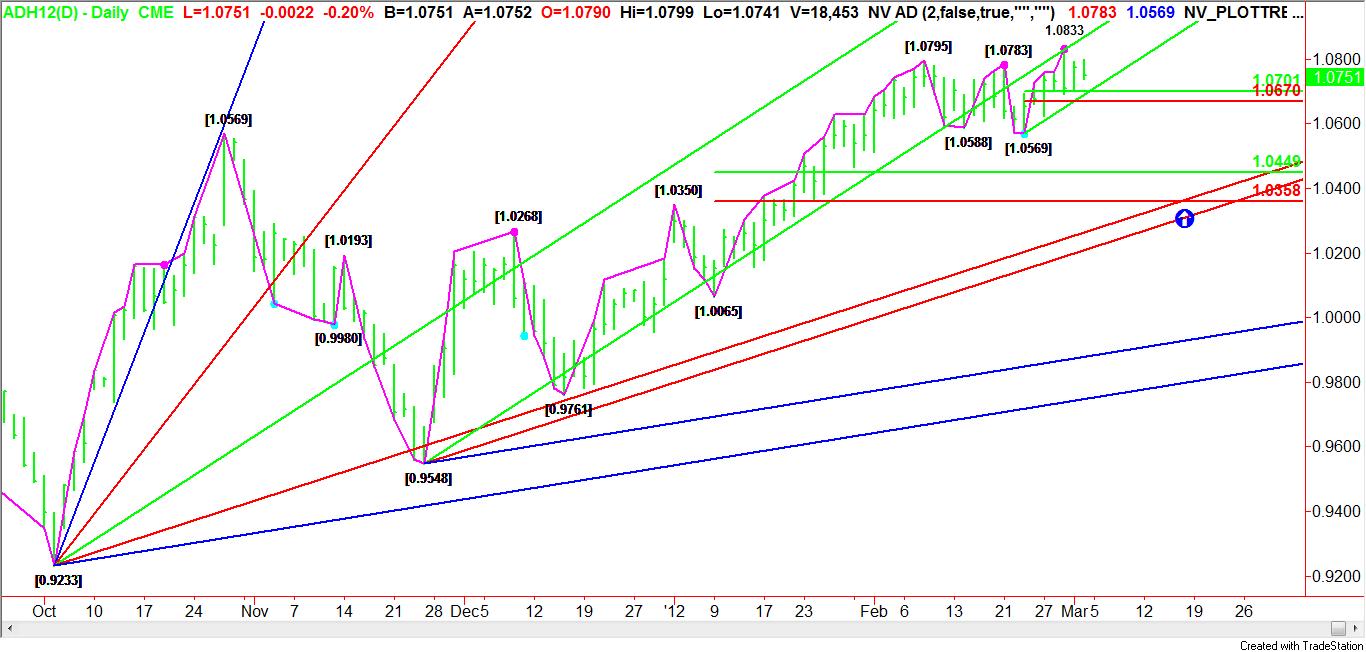The March Australian Dollar is trading weaker overnight after failing to take out the high for the week at 1.0883. The subsequent turnaround could pressure the market later today. The daily chart indicates that a trade through 1.0693 will confirm a closing price reversal top formed earlier in the week.
Based on the short-term range of 1.0569 to 1.0833, expectations are for the Aussie to find short-term support at 50 percent of this range at 1.0701. This is followed by an additional retracement level target at the Fibonacci level of 1.0670. Before the market can reach this level, however, it must break a minor uptrending Gann angle at 1.0689.
Besides the closing price reversal top which usually indicates the start of a 2 to 3 day break once it is confirmed, the Australian Dollar may also be forming a minor triple top. This pattern will be verified if the market breaks the swing bottom at 1.0569.

In addition to confirming the triple top, a failure to provide support at 1.0569 will mean the daily main trend has turned down. Looking at the major range of 1.0065 to 1.0833 for guidance, traders may try to break into the retracement zone of this range at 1.0449 to 1.0356. This is followed by an uptrending Gann angle target at 1.0263. This angle will cross the lower retracement price target at 1.0356 on March 16. A test of this price at that time will square price and time and could trigger a technical bounce to the upside.
Earlier in the week, the Australian Dollar reached a multi-month high versus the U.S. Dollar because of an improving growth outlook. In addition, the strong interest in the European Central Bank LTRO program spurred fresh demand for higher yielding assets.
The potentially bearish closing price reversal top formation put a short-term negative spin on the Aussie after U.S. Federal Reserve Chairman Ben Bernanke failed to convince traders that another round of quantitative easing was in order. This news caused speculators to pare their long positions. Although the technical charting pattern may be indicating a possible break, traders appear to be waiting for more economic news from the U.S. as well as indications that the turmoil in the Euro Zone is settling.
Next week the Reserve Bank of Australia meets to decide its interest rate policy. Expectations are for the central bank to leave interest rates at 4.25 percent, but hint that it will likely raise rates at its next meeting if global economic conditions continue to improve. The RBA will also base its decision on how it perceives risk and most analysts agree that risk may be lessening now that Greece has received its bailout money and while the ECB continues to provide liquidity when needed.
Based on the short-term range of 1.0569 to 1.0833, expectations are for the Aussie to find short-term support at 50 percent of this range at 1.0701. This is followed by an additional retracement level target at the Fibonacci level of 1.0670. Before the market can reach this level, however, it must break a minor uptrending Gann angle at 1.0689.
Besides the closing price reversal top which usually indicates the start of a 2 to 3 day break once it is confirmed, the Australian Dollar may also be forming a minor triple top. This pattern will be verified if the market breaks the swing bottom at 1.0569.

In addition to confirming the triple top, a failure to provide support at 1.0569 will mean the daily main trend has turned down. Looking at the major range of 1.0065 to 1.0833 for guidance, traders may try to break into the retracement zone of this range at 1.0449 to 1.0356. This is followed by an uptrending Gann angle target at 1.0263. This angle will cross the lower retracement price target at 1.0356 on March 16. A test of this price at that time will square price and time and could trigger a technical bounce to the upside.
Earlier in the week, the Australian Dollar reached a multi-month high versus the U.S. Dollar because of an improving growth outlook. In addition, the strong interest in the European Central Bank LTRO program spurred fresh demand for higher yielding assets.
The potentially bearish closing price reversal top formation put a short-term negative spin on the Aussie after U.S. Federal Reserve Chairman Ben Bernanke failed to convince traders that another round of quantitative easing was in order. This news caused speculators to pare their long positions. Although the technical charting pattern may be indicating a possible break, traders appear to be waiting for more economic news from the U.S. as well as indications that the turmoil in the Euro Zone is settling.
Next week the Reserve Bank of Australia meets to decide its interest rate policy. Expectations are for the central bank to leave interest rates at 4.25 percent, but hint that it will likely raise rates at its next meeting if global economic conditions continue to improve. The RBA will also base its decision on how it perceives risk and most analysts agree that risk may be lessening now that Greece has received its bailout money and while the ECB continues to provide liquidity when needed.
